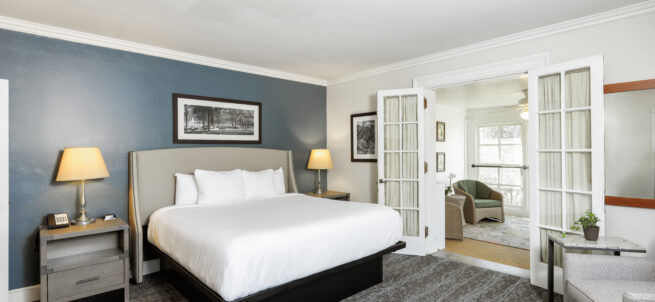Gideon Putnam History
The Origins of the Gideon Putnam Hotel
The Gideon Putnam Hotel is appropriately named after one of Saratoga Springs’ first settlers. Gideon Putnam, a “founding father” of the city and the founder of the hotel business in Saratoga Springs, occupies an important place in Saratoga’s history.
-
1763–1789: Early Life & Arrival in Saratoga
Gideon Putnam was born in Massachusetts in 1763, descended from a family of early settlers and Revolutionary War heroes. His most famous relative was his cousin, General Israel Putnam, who would demonstrate similar tenacity as one of Saratoga’s first entrepreneurs.
In 1789, Gideon and his wife, Doanda Risley Putnam, arrived in Saratoga Springs after living in Middlebury and Rutland, Vermont. Upon arriving in Saratoga Springs, Gideon described the area as a little more than “forest with a few log houses and mineral spring.” The spring that he was referring to, High Rock Spring, had long been known to the Mohawk and Oneida Indians for its healing properties. The native people called the area “Sarahoga,” meaning “place of swift water.”
George Washington, Phillip Schuyler and Alexander Hamilton visited the area, all drawn by the legends of the spring’s curative powers. Today, the spring can be visited in High Rock Park near downtown Saratoga.
-
1790s–1802: A Growing Business & Family Life
Settling near High Rock Spring, known as the “upper village,” Gideon began his first business venture in lumber, producing barrel staves and shingles transported down the Hudson River to be sold in New York City. Doanda and Gideon grew their family, eventually to nine children, including the first child of European descent born in Saratoga: Lewis Putnam.
Gideon later purchased land around Congress Spring and, in 1802, opened the 70-room Putnam Tavern and Boarding House, inspired by the success of the hotel that sprung up around the mineral springs in nearby Ballston Spa. Despite local skepticism — earning it the nickname “Putnam’s Folly” — the tavern prospered. Doanda had hand-painted a sign depicting Israel Putnam’s legendary wolf hunt, which hung outside the tavern. It can still be seen today at the museum operated by the Historical Society of Saratoga Springs.
-
1810–1812: Expansion & Legacy
By 1810, Gideon expanded his hotel, renaming the hotel Union Hall, which his family would continue to operate until 1864. The hotel later grew to encompass an entire city block and became known as the Grand Union Hotel, one of the largest and most famous hotels in the world. The hotel dominated the Saratoga scene from 1876 to 1953, when it was demolished to make way for a supermarket and parking lot.
Gideon also developed the city’s first bathhouse and laid out Saratoga’s early street grid, reserving land for a church, school and cemetery. Tragically, during construction in 1811 of a new hotel — Congress Hall — Gideon suffered a serious injury and died in 1812 at age 49. He was the first to be buried in the cemetery he himself had designated, now known as the Gideon Putnam Burial Ground. In addition to Gideon, Doanda and a number of their children are also buried in the same cemetery, located just off South Franklin Street.
-
1812–1864: A City Built on Vision
After Gideon’s death, Saratoga Springs continued to grow and take shape almost exactly along the lines that its “founding father” had envisioned. Union Hall evolved into the Grand Union Hotel, and his plans for the village’s layout became the foundation of the town. The flourishing system of springs, bathhouses and hotels soon resulted in Saratoga becoming known as the “Queen of Spas.”
By the mid-19th century, politicians, entertainers, aristocrats and artists came to Saratoga drawn by the famed healing powers of the springs. Daniel Webster, Martin Van Buren, James Buchanan, Washington Irving, James Fenimore Cooper, Edgar Allan Poe and Nathaniel Hawthorne were names that could be found in the registries of any one of the great hotels during this time.
-
1863–1900: An Evolving Reputation
In the latter part of the nineteenth century, Saratoga developed other attractions. In 1863, John Morrissey established the city’s first Thoroughbred racetrack, the Saratoga Race Course, and later the city’s first casino, known today as the Canfield Casino. Saratoga soon became famous not only for its springs, but for racing, gambling and its vibrant social scene. Slightly more infamous celebrities began to be drawn to the area, including Lillian Russell and “Diamond Jim” Brady.
By the turn of the century, Saratoga’s popularity would prove a detriment to the fundamental qualities that enabled its initial growth. In 1890, a process was developed to extract carbon dioxide gas from the waters of the springs for sale to soda fountains. Unregulated bottling and continued exploitation of the wells lowered water levels and robbed the water of its carbonation to such an extent that the springs were in danger of disappearing.
-
1909–1935: Preservation and the Birth of the Hotel
Recognizing the fragility of this natural asset, the state of New York established the New York State Reservation at Saratoga Springs in 1909, purchasing approximately two square miles of land around the endangered springs. For eight years, the springs were allowed to rest in the hope of restoring them to their former levels.
In 1913, Dr. Simon Baruch, a pioneer of hydrotherapy, was hired to evaluate the medicinal properties of the springs. George Foster Peabody, Spencer Trask (owner of the Saratoga estate Yaddo; now an artists’ retreat) and Simon Baruch’s son, Bernard Baruch, financier and adviser to several presidents, were all early proponents of the State Reservation.
Over the next two decades, $9 million was invested to build a number of structures on the State Reservation, funded in part by the federal government’s Reconstruction Finance Loans. Billed as “America’s First European Spa,” the complex included the Washington, Lincoln and Roosevelt mineral baths, the Simon Baruch Research Institute, the Bottling Plant, the Victoria Pool, the Hall of Springs, a nine-hole golf course and a small hotel named in honor of Saratoga’s founding father; The Gideon Putnam Hotel.
-
1935-1941: Opening and Growth of The Gideon Putnam Hotel
The Gideon Putnam Hotel opened in 1935 with 87 guestrooms, similar to Putnam’s original Boarding House and Tavern, and was conceived as a convenient, ideally located means of accommodating visitors seeking relief at the nearby Spa. Stays of up to three weeks were recommended for maximum benefit, and a single room with a bath was $12. A strict dress code was enforced, prohibiting sleeveless dresses in the dining room.
Several notable figures were involved with the design of the hotel, including Marcus T. Reynolds, Albany’s most prominent architect of the time. Built in the Colonial Revival/Neo-Georgian style, The Gideon Putnam Hotel was elegant without being overly ornate and did not detract from the other features of the State Reservation.
Internationally acclaimed artist James Reynolds created the murals in the dining room, depicting scenes from Saratoga society and the Adirondacks. Dorothy Tuckerman Draper, one of the most successful interior designers of the 1930s and ‘40s, was commissioned to decorate the interior of the hotel. The bright, vivid colors of her designs were intended to relax and invigorate visitors in keeping with the overall mission of the Spa — the healing of bodies and spirits.
The State Reservation proved to be a resounding success. In 1935, 25,000 people visited the Spa. During the first decade of operation, the bathhouses were full, and the hotel was perpetually booked. Just as Gideon Putnam had to expand his thriving boarding house a century earlier to accommodate growing numbers of guests, the hotel named in his honor was doing the same, and a west wing was added in 1942.
-
1940s–1960s: Challenges with Modern Advances
The Gideon Putnam thrived before changes in medicine and travel behaviors began to shift the resort’s appeal. Celebrities such as Bob Hope, Fred Astaire, Cary Grant, Chief Justice Charles Evans Hughes and the Whitney family were among notable guests in this era. However, by the late 1940s, advances in medicine and science were eradicating many of the ailments that visitors had “taken the waters” to cure. Vacation preferences were also changing; long vacations in one spot were becoming less popular due to the automobile. Very quickly, the selling points of a spa retreat were being rendered obsolete.
-
1950s–1970s: Upgrades & Modernization
The Gideon Putnam would undergo a series of renovations and expansions throughout the years to come. By 1953, a redecoration of most of the ground floor was completed. In 1966, the new Saratoga Performing Arts Center, located less than half a mile away, attracted new visitors, and eventually new celebrities, to the hotel. Among them, opera star Beverly Sills and the rock band the Grateful Dead.
In 1969, former servants’ quarters on the fifth floor were renovated, adding fourteen additional guestrooms. The $750,000 construction and renovation project also included the addition of a new cocktail lounge, “The Arches,” named for its classic brick arches, patterned after those found throughout the Spa.
In 1979, a 9,000-square-foot convention center was added that offered seating for 700. The convention center was named for Sir William Johnson, who, as legend has it, was one of the first Europeans to be brought to the High Rock Spring by native people in 1771 for treatment of a war wound.
-
1980s–Today: National Attention & Historic Preservation
Between 1988 and 1990, another $3 million was spent for new electrical wiring, new plumbing, kitchen upgrades and room renovations at the hotel. Still attracting celebrity appeal, Robert Redford stayed at The Gideon Putnam in 1997 while filming scenes from “The Horse Whisperer,” and a scene from Dustin Hoffman’s “Billy Bathgate” was shot in the hotel lobby in 1991.
Commonly referred to as the “Jewel of Saratoga,” The Gideon Putnam stands as a reminder of Saratoga’s past as it adapts to serve the needs of the present. The hotel, now offering 123 guestrooms, is listed in the National Trust for Historic Preservation’s guide to Historic Hotels of America, and the hotel’s setting, the 2,200-acre Saratoga Spa State Park, is designated a National Historic Landmark.
With roots reaching back to the original inhabitants of the area, The Gideon Putnam continues to blend tradition and elegance to create a timeless experience, representing all that Gideon Putnam envisioned two centuries earlier.

Stay
Have it all with charming features, modern accommodations and an unbeatable location.

Roosevelt Baths & Spa
Unwind at our full-service spa with nature-inspired therapies and healing mineral waters.













